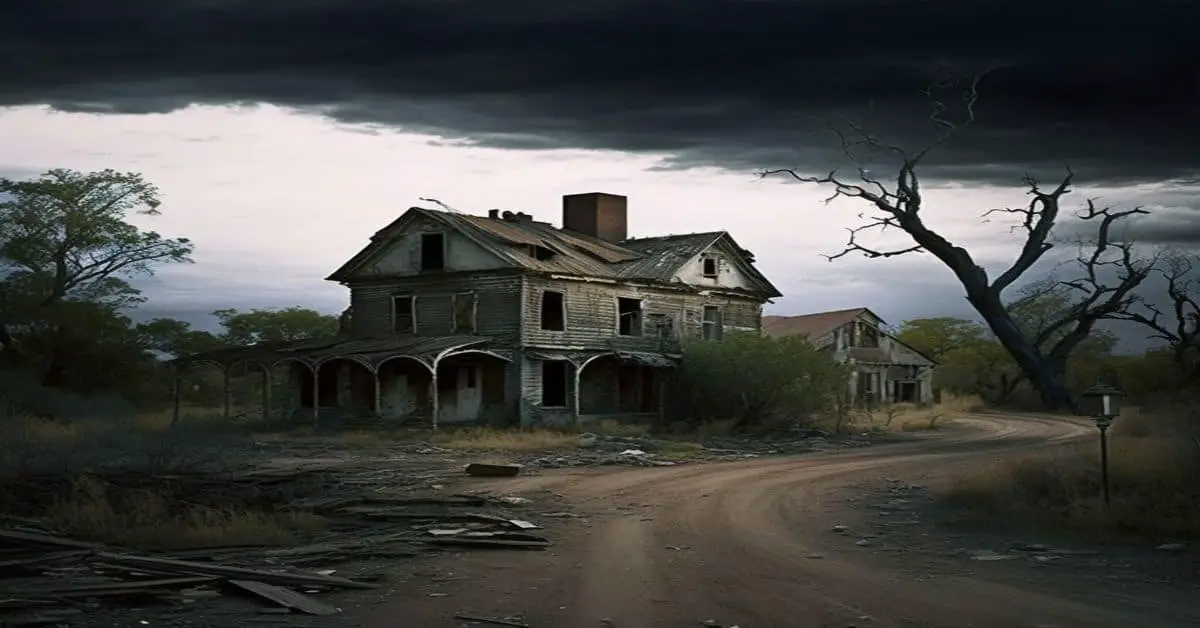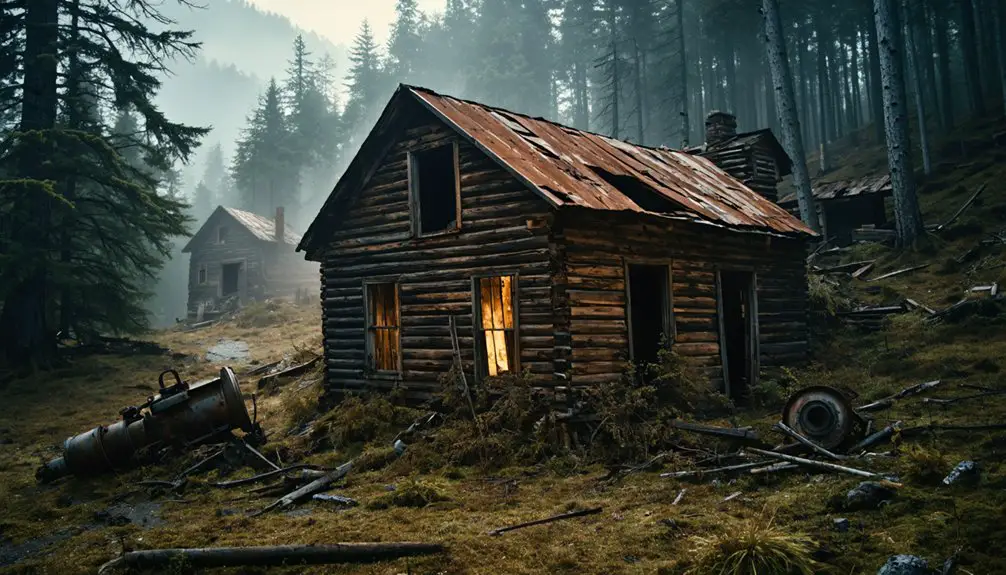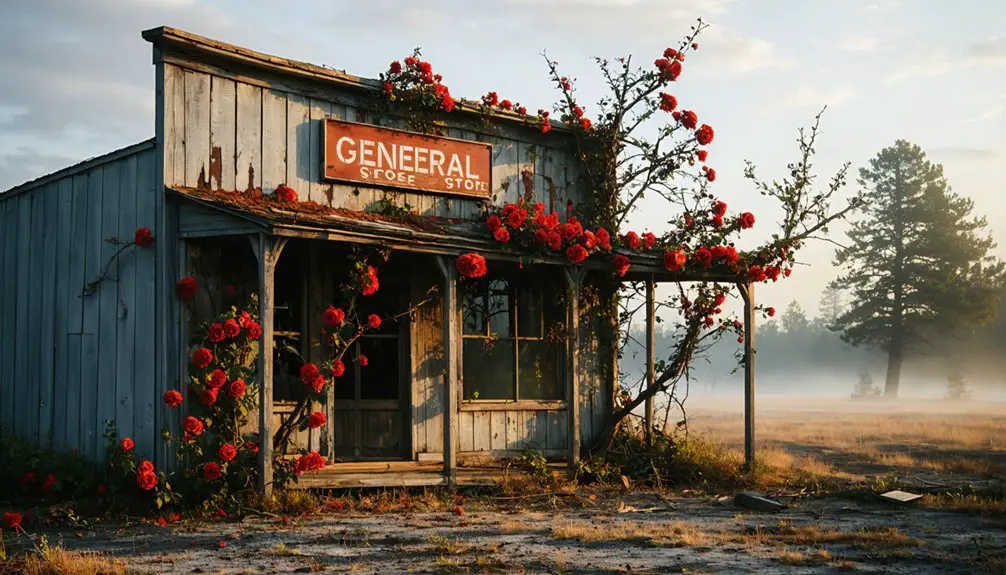You’ll find the abandoned mill town of Skipnish tucked away in Maryland’s countryside, where nature now claims what floods left behind. Founded in 1810 as a textile manufacturing hub, the town thrived until the devastating floods of 1936, 1955, and 1972 forced residents to leave their homes behind. Today, crumbling stone foundations, an old church, and ivy-covered ruins tell tales of its industrial past, ghostly legends, and the community that once called this place home.
Key Takeaways
- Skipnish was established in 1810 as a textile mill town in Maryland, originally named Ellisville, reaching its peak population in the mid-1960s.
- The Record Flood of 1936 initiated the town’s decline, with subsequent hurricanes Diane (1955) and Agnes (1972) forcing residents to abandon their homes.
- Historic ruins include stone church remains, old mill foundations, and deteriorating structures now marked with “No Trespassing” signs for safety.
- Nature has reclaimed the abandoned town, with thick ivy and moss covering stone foundations while wildlife creates new habitats.
- Local ghost stories and paranormal activities are reported near the century-old cemetery, adding to Maryland’s supernatural heritage.
Historical Origins of Skipnish
Skipnish’s roots trace back to 1810 when Thomas Ellie established a textile mill in what would become a thriving industrial town.
You’ll find that the community initially went by other names, including “Ellisville” by the 20th century, reflecting the influence of founding families in the region.
Like many mill towns of the era, Skipnish developed under the watchful eye of its industrial leaders, who controlled everything from housing to stores.
Similar to the Gary family approach, owners provided churches, entertainment facilities, and other amenities to create an idealized community atmosphere.
The textile industry brought steady growth to the area, with mill owners assuming paternalistic roles in managing the town’s daily operations.
While historical records of Skipnish remain limited, its development pattern mirrors that of other Maryland mill towns, where industrialists built self-contained communities around their manufacturing operations.
The town reached its peak population with over 90 families residing there during the mid-1960s, shortly before the mill’s closure marked the beginning of its decline.
Life in the Mill Town Era
You’d find mill workers rising early to begin their daily tasks at Marsh’s Mill, where families like the Lehmans managed operations producing over 4,000 barrels of flour annually alongside other grains.
In the tight-knit community of Skipnish, you’d see locals gathering at the 1832 village church and sharing stories near the cool caves beneath the mill houses where they stored pies. By the late 1960s, ninety mill families lived and worked in the close community. The town followed similar patterns to those seen in Union Mills Maryland, with its rich milling heritage and preserved historical sites.
Your journey through the mill town would reveal modest homes clustered around the mill, where both free laborers and enslaved workers like Chatham contributed to the town’s bustling grain production and maintenance of the water-powered machinery.
Daily Mill Worker Routines
The daily rhythm of mill work in Skipnish began before dawn, as workers filed into the bustling complex around 5 or 6 a.m. to maximize precious daylight hours.
You’d spend 10-12 hours at your assigned mill worker roles, whether operating machinery, maintaining equipment, or preparing finished goods for transport. Similar to the historic Jerusalem Mill, workers supplied essential flour and materials to support military efforts during wartime. The village prospered as a Quaker settlement where residents lived and worked together in the community.
Living close to the mill meant you could quickly respond to emergencies, but it also meant your life revolved around the factory’s demands.
Between shifts, you’d manage these essential daily routines:
- Prepare simple meals to sustain through long workdays
- Care for family members and tackle household chores
- Visit the local general store for necessities and socializing
The six-day workweek left little time for rest, with Sundays reserved for religious observance and recovery from the physically demanding labor.
Local Community Gatherings
Despite long hours at the mill, community life in Skipnish flourished through vibrant social gatherings that brought workers and families together.
You’d find yourself drawn to the social halls where ceilidhs, influenced by Scottish immigrants, filled the air with music, dance, and storytelling, strengthening community bonds among mill workers.
Throughout the year, you could participate in seasonal festivals that aligned with agricultural cycles, while religious occasions at the local church provided additional opportunities for cultural celebrations. The warm rural hospitality made newcomers feel instantly welcome at these cherished events.
The mill’s common areas transformed into spaces where you’d share collective meals with neighbors, exchange news, and support one another through informal mutual aid networks. Traditional Scottish music echoed through these gatherings, as local musicians carried on their cultural heritage.
Children’s games and sports activities would unfold naturally, while traveling entertainers brought fresh excitement to these cherished gatherings.
Housing and Living Conditions
Life in Skipnish’s mill town housing reflected the stark realities of industrial-era living conditions.
You’d have found yourself in a modest wood-frame or brick row house, sharing cramped quarters with your family or fellow workers. The housing conditions were basic, with outhouses instead of indoor plumbing and wood stoves that filled rooms with smoke. Much like the heritage preserved by Highland and Islands musicians today, these homes represented a significant piece of working-class history.
Worker welfare often depended on the mill owner’s whims, as they controlled both your employment and housing.
You’d have faced these daily challenges:
- Constant noise and vibrations from nearby mill machinery disrupting your rest
- Limited insulation leaving you cold in winter and sweltering in summer
- Shared water access through communal pumps or wells
Your rent would’ve been automatically deducted from your wages, creating a cycle of dependency that tied your housing security directly to your mill employment.
The Great Flood and Abandonment
Following months of heavy precipitation and snowmelt, devastating floodwaters engulfed Skipnish during the Record Flood of 1936, marking the beginning of the town’s eventual abandonment.
You’d have witnessed waters rising up to 15 feet, destroying homes, businesses, and essential infrastructure while leaving behind thick layers of mud and contaminated debris. Despite initial attempts at flood resilience, the town’s geography made it particularly vulnerable to future disasters.
The community recovery proved increasingly difficult as subsequent floods, including those from Hurricane Diane in 1955 and Hurricane Agnes in 1972, repeatedly battered the area. The storm’s impact was particularly severe, causing $1 billion in damages across the Eastern United States.
You would’ve seen families gradually relocating as the economic toll mounted. With damaged transportation routes isolating the community and agricultural land degrading from repeated flooding, Skipnish’s residents ultimately surrendered their hometown to nature’s relentless force.
Exploring the Modern Ruins
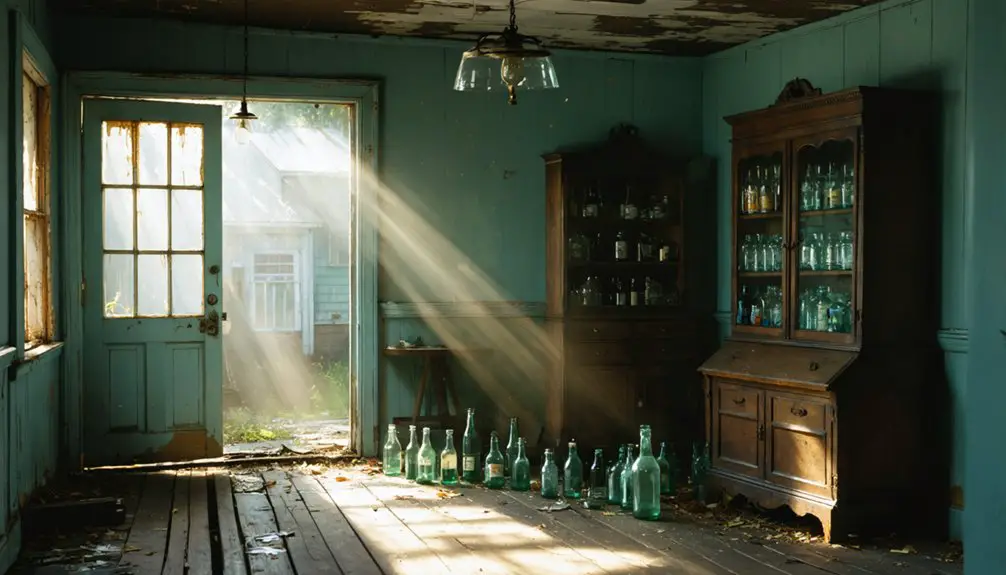
As you walk through Skipnish’s overgrown paths today, you’ll find scattered remnants of the St. Albins Episcopal Church tower and the Pentecostal Holiness Church ruins still standing among dense vegetation.
You’ll need to watch your step around unstable foundations, collapsed walls, and the many abandoned vehicles frozen in time since the 1972 flood.
While these historic structures offer fascinating glimpses into the past, stay clear of any buildings marked with “No Trespassing” signs and avoid entering deteriorating structures that could collapse.
Hidden Structures Still Standing
While nature reclaims much of Skipnish’s abandoned landscape, several remarkable structures still pierce through the overgrowth, telling stories of Maryland’s forgotten communities.
You’ll discover hidden architecture scattered throughout the area, from stone church ruins with their fire-scarred walls to old mill foundations that hint at bustling industrial days. Urban exploration reveals these haunting remnants, now adorned with ivy and modern murals.
- Gothic stonework stands defiant against time, maintaining its structural integrity despite decades of abandonment.
- Secret stairways near railroad bridges lead to elevated ruins, offering adventurous paths to unexplored territories.
- Metal crosses and painted symbols mark former sacred spaces, creating an enigmatic atmosphere among the decay.
These surviving structures serve as portals to a bygone era, waiting for those bold enough to venture off the beaten path.
Dangerous Areas to Avoid
Because safety must be the top priority when exploring Skipnish’s ruins, several dangerous areas demand extreme caution or complete avoidance.
You’ll need to steer clear of hazardous structures with deteriorating foundations and unstable walls, particularly those covered in thick ivy that masks structural weaknesses.
The old mill area and dam remnants contain hidden shafts and flood zones that could prove lethal, especially during wet seasons when flash flooding remains a serious threat.
Stay away from any buildings showing signs of imminent collapse, and don’t venture onto railroad tracks or cross waterways illegally to access sites.
The most treacherous spots include areas with scattered industrial debris, contaminated buildings containing asbestos, and remote sections where emergency help can’t easily reach you.
Supernatural Tales and Local Legends
Since its abandonment in the early 1970s, Daniels has cultivated a haunting reputation steeped in tales of supernatural occurrences and ghostly encounters.
You’ll find the remnants of this once-thriving textile mill town now shrouded in mystery, where supernatural encounters are frequently reported among the ivy-covered ruins and forgotten foundations.
- The town’s abrupt evacuation and subsequent destruction by Hurricane Agnes in 1972 sparked stories of divine intervention and lingering spirits.
- Local legends tell of ghostly apparitions near the century-old cemetery, where unexplained lights and eerie sounds break the unusual silence.
- Paranormal investigators document strange phenomena throughout the ruins, from phantom factory workers to mysterious shadows near abandoned structures.
These haunting tales have transformed Daniels from a forgotten industrial town into a powerful symbol of Maryland’s supernatural heritage.
Natural Reclamation and Wildlife
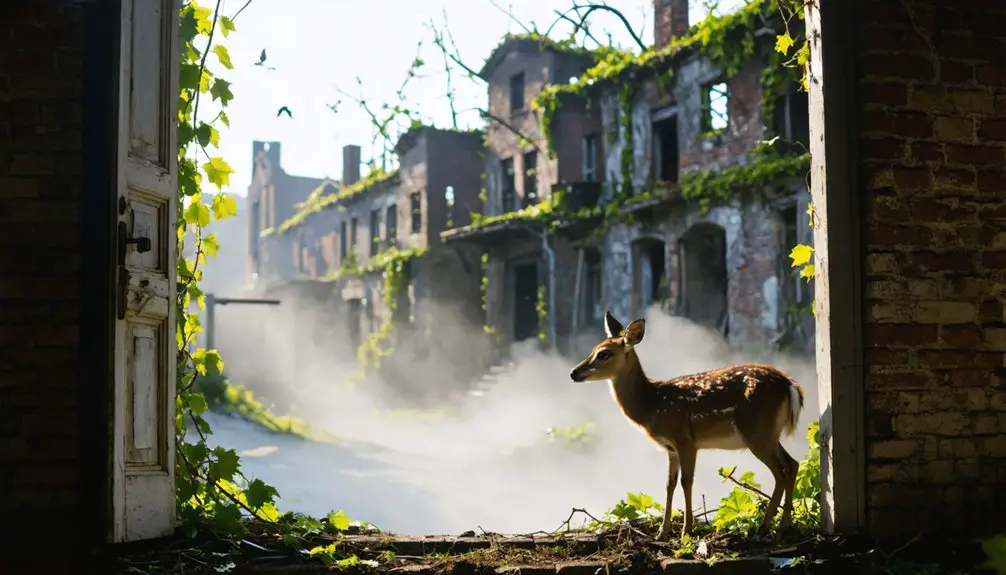
Nature has steadily reclaimed the abandoned streets and buildings of Skipnish, transforming this once-bustling mill town into a symbol of ecological restoration.
You’ll find thick ivy and moss blanketing stone foundations, while fallen leaves carpet the remnants of old roads. Hurricane Agnes’s fury in 1972 accelerated this return to wilderness.
Wildlife interactions are abundant throughout the ghost town’s grounds. Deer roam freely among the ruins, while birds nest in deteriorating structures.
You’ll spot squirrels, raccoons, and possibly foxes in the surrounding woods. The mix of overgrown spaces creates diverse habitats, though some challenges remain.
Concrete foundations still limit root growth, and scattered debris poses obstacles to larger animals. Despite these hurdles, you’re witnessing a remarkable reflection of nature’s persistence, as Skipnish slowly dissolves back into the Maryland landscape.
Preservation Efforts and Heritage
While a handful of Skipnish’s structures have earned recognition from preservation organizations, the town’s historical legacy remains largely unprotected.
You’ll find preservation challenges mounting as natural decay and development pressures threaten the remaining buildings. Community involvement has emerged through local historical societies and volunteer groups, though limited funding and private ownership issues continue to hinder restoration efforts.
- The town’s church stands as one of the few maintained structures, now serving as an educational heritage site.
- Local nonprofits have installed interpretive signage and historical markers to share Skipnish’s story.
- Adaptive reuse initiatives aim to transform select buildings into community spaces while preserving their historical character.
Despite these obstacles, dedicated preservationists continue working to protect what remains of Skipnish’s architectural heritage, ensuring future generations can connect with this piece of Maryland’s past.
Visitor’s Guide to the Ghost Town
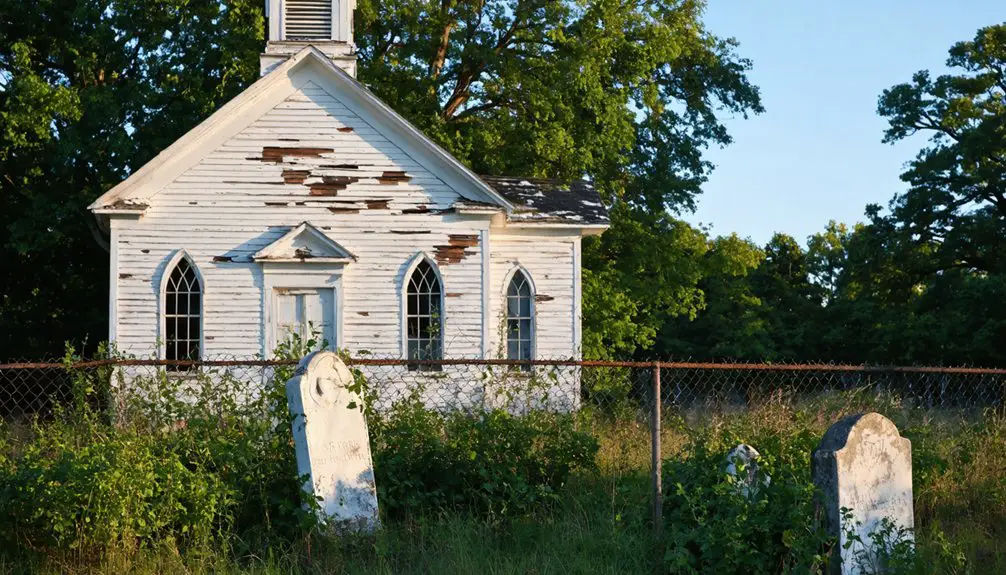
Ready to explore the haunting remains of Skipnish? You’ll find this forgotten Maryland town along the Patapsco River corridor, accessible through dirt roads and winding trails.
For the best photographic opportunities, visit during spring through fall, when autumn colors transform the landscape and natural light bathes abandoned artifacts in a nostalgic glow.
Pack water and hiking gear, as you’ll encounter uneven terrain and possibly marshy areas near the river. You can discover mill foundations wrapped in thick ivy, weathered gravestones, and scattered relics of the town’s industrial past.
While exploring, stay alert – some structures remain unstable. There’s no cell service in many areas, so let someone know your plans.
For navigation, grab local maps or GPS coordinates from ghost town resources before your adventure.
Frequently Asked Questions
Are There Any Dangerous Animals or Snakes to Watch Out For?
You’ll find minimal wildlife encounters, but watch for copperheads and timber rattlesnakes in rocky areas. Snake identification skills help, though most snakes you’ll spot are harmless black rat snakes.
Can Metal Detectors Be Used to Search the Ruins?
All that glitters isn’t gold – you can’t legally use metal detectors at these ruins. Metal detecting and treasure hunting require special permits to protect historic artifacts and archaeological sites.
What Happened to the Residents’ Belongings After They Left?
You’ll find most residents took their belongings when they left, though some abandoned treasures remained behind. Lost memories include vehicles and personal items hastily left during the rushed one-year evacuation period.
Is Camping Allowed Near the Ghost Town Site?
You can’t camp at the ghost town site due to regulations, but you’ll find designated campsites within Patapsco Valley State Park nearby where you’re welcome to stay overnight legally.
Do Any Descendants of Original Residents Still Visit Regularly?
Presently, you’ll find no documented proof of descendants doing regular visits. While family reunions and historical tours happen in many ghost towns, there’s no clear evidence of organized descendant gatherings at this site.
References
- https://www.youtube.com/watch?v=r2OfPLbcU3k
- https://www.youtube.com/watch?v=sbFq0i5w0-c
- https://www.youtube.com/watch?v=nJzauuAFgr0
- https://www.tripadvisor.co.uk/Attraction_Review-g41131-d10035193-Reviews-Daniels_Ghost_Town-Ellicott_City_Maryland.html
- https://www.youtube.com/watch?v=XgE8IPwHdI0
- https://www.youtube.com/watch?v=txdL6qhPAMc
- https://www.youtube.com/watch?v=ONtJ-QTcMWo
- https://en.wikipedia.org/wiki/List_of_ghost_towns_in_Maryland
- https://spoommidatlantic.org/uploads/editor/files/Milling_History/WashCounty MD Book3.pdf
- https://msa.maryland.gov/megafile/msa/speccol/sc4300/sc4300/000005/000000/000015/restricted/carrol_county_mills.doc.pdf

